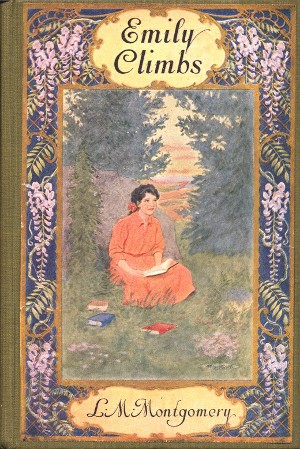
In this sequel to Emily of New Moon, Emily is 14 years old and has successfully graduated from the local country school. In order for Emily to go on to high school, she has to board in town with nasty, suspicious Aunt Ruth. Aunt Ruth is a trial to Emily because if she doesn’t understand why Emily does what she does, Aunt Ruth always suspects her of being sly. Aunt Ruth seldom understands Emily.
Another condition of attending high school is that she has to promise Aunt Elizabeth that she will give up writing anything that isn’t true. It is truly a sacrifice for Emily to give up writing the stories so dear to her, but she later realizes she has learned discipline that has honed her writing.
Emily has her successes and failures throughout high school, but the scale is heavier on the success side. She really does try to be good and to uphold the Murray tradition of proper behavior. The scrapes she’s involved in are usually the result of misunderstandings.
One of the benefits to our children in reading the old-fashioned stories is in watching the characters trying to live out a standard of behavior that everyone in the community seems to instinctively understand. The Murrays believe their standard is higher than most, but Emily takes it seriously and works diligently not to disgrace her family name. Whether we agree with the standards of the past or not, the general understanding of them is part of what held society together and enabled people to function within their communities. There is value for our children in seeing a character such as Emily putting aside her selfish tendencies and learning to think of others first. Or, at least, before making a final decision. As young as Emily is, she understands that she owes a debt to her forebears, respect to her elders, and has a responsibility to posterity.
At the end of New Moon, there is an incident where somehow, when Emily is sick, she has a dream that solves the mystery of Ilse’s mother’s disappearance. It is unsettling to everyone, but, though “second sight” is suggested, most people seem to be content to call it a coincidence. In Emily Climbs, we are left without a doubt that Emily has some sort of psychic ability. She never becomes comfortable with it and does her best to keep it hidden, but she can no longer deny that it is true. Early in the book, Emily gets locked inside the church alone during a terrible storm. In terror, she finally calls out to her friend Teddy, and he “hears” her from more than a mile away. Later, Emily goes to sleep troubled about a little boy who has been missing long enough that most people assume he is dead. In her sleep, by means of what Montgomery seems to intend to be automatic writing, Emily solves the mystery of the boy’s whereabouts and saves his life.
For some families, this could be a troubling aspect of Emily’s character. It adds little to the story, in my opinion, but may have simply been an attempt to satisfy a popular fascination with spiritualism. It seems to me that Montgomery identified with Emily more than with any of her other characters. As in the first book, Montgomery attributes an incident to Emily’s life that she had mentioned about herself in The Alpine Path, a story she wrote about her own career many years before she wrote the Emily books. The title, Emily Climbs, refers to that Alpine Path Emily, like Montgomery, has chosen to climb toward success. If I understand correctly from bits of Montgomery’s life gathered from here and there, she was never able to clearly define her faith. Perhaps in Emily she is attempting to work out some of her beliefs and doubts. This could be used as an opportunity to discuss this topic with an older teen.
By the end of the book, Emily is 17. Too young to marry, according to Aunt Elizabeth, but not too young for her to have had a few proposals before it’s over. Perry periodically asks her to marry him and even manages to sneak a kiss just as Aunt Ruth catches him with Emily in an awkward, but innocent, situation. By the end of the book, we also know whom Emily prefers. “Once Emily, glancing up suddenly, found Teddy looking at her strangely. For just a moment their eyes met and locked—only a moment—yet Emily was never really to belong to herself again.”
Emily is still her sweet self in this book, but she has matured far beyond the Emily who first came to New Moon after her father’s death. If you are choosing to limit romantic content for younger children, you will want to save this for older teens.